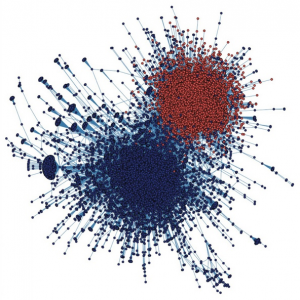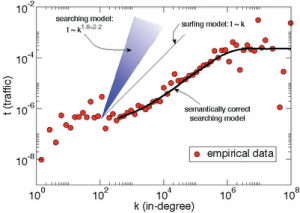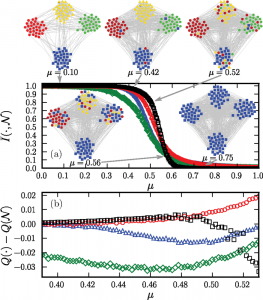Recently Funded Projects
- DOISAC: Detecting Orchestrated Information and Synthetic Account Campaigns
ONR STTR Phase I, June 2015 – June 2016
co-PI, in collaboration with Aptima and University of Southern California - Large Meme Diffusion Through Mass Social Media
NSF – ICES program, June 2011 – June 2016
co-PI, in collaboration with A. Vespignani (NorthEastern) and F. Menczer and J. Bollen (IU) - DESPIC: Detecting Early Signatures of Persuasion Campaigns
DARPA – SMISC program, January 2013 – May 2015
PI, in collaboration with U. Michigan and Lockheed Martin Advanced Technology Lab - Contagion of Ideas in Online Social Networks
James Mc Donell Foundation – 21st Century Science Initiative-Studying Complex Systems / SCS Research, January 2012 – January 2016
co-PI, in collaboration with F. Menczer (IU)
 Social media offer a very powerful microscope to discover and understand patterns in the real world. We leveraged, for example, conversations on Twitter to study the evolution of social protests such as Occupy Wall Street and Gezi Park, and the issue of polarization in US public political discourse.
Social media offer a very powerful microscope to discover and understand patterns in the real world. We leveraged, for example, conversations on Twitter to study the evolution of social protests such as Occupy Wall Street and Gezi Park, and the issue of polarization in US public political discourse.
References:
The digital evolution of Occupy Wall Street, PLoS ONE, 8(5):e64679, 2013.
The geospatial characteristics of a social movement communication network; PLoS ONE, 8(3):e55957, 2013.
Evolution of online user behavior during a social upheaval; Proceedings of the 2014 ACM Conference on Web Science, 81-90, 2014. [Best Paper Award]
Political polarization on Twitter; In: Proceedings of the 5th International AAAI Conference on Weblogs and Social Media, ICWSM 2011
 The rising popularity of online social networks (OSN) is changing how and with whom we communicate. This has profound consequences on the mechanisms underlying individual and collective information production, sharing, filtering, and consumption.
The rising popularity of online social networks (OSN) is changing how and with whom we communicate. This has profound consequences on the mechanisms underlying individual and collective information production, sharing, filtering, and consumption.
Issues I care about include: how does information spreads on online social networks, and how do they evolve in response? Do OSN enhance or suppress “filter bubbles”? What are the consequences of the information overload that OSN generate, and how these affect the cycle of information production/consumption?
References:
The role of information diffusion in the evolution of social networks; In: Proceedings of the 19th ACM SIGKDD Conference on Knowledge Discovery and Data Mining, KDD 2013.
Measuring online filter bubbles, submitted, 2015
Competition among memes in a world with limited attention; Nature Scientific Reports, 2, 335, 2012
The production of information in the attention economy; Scientific Reports , 5, article #: 9452, doi:10.1038/srep09452, 2015.
 For several years now, we have been collecting data about online human activity, from Web clicks to Twitter posts. These data have inspired a number of theoretical studies on macroscopic patterns of information diffusion. We studied the bursty nature of online popularity, how the competition for our attention globally affects the life cycle and perceived importance of information, the role played by communities in enhancing or suppressing the spread of information, and the effects of our exposure to the aggregated activity of others (such as that implicitly provided by the ranking of search engines.)
For several years now, we have been collecting data about online human activity, from Web clicks to Twitter posts. These data have inspired a number of theoretical studies on macroscopic patterns of information diffusion. We studied the bursty nature of online popularity, how the competition for our attention globally affects the life cycle and perceived importance of information, the role played by communities in enhancing or suppressing the spread of information, and the effects of our exposure to the aggregated activity of others (such as that implicitly provided by the ranking of search engines.)
References:
Characterizing and modeling the dynamics of online popularity; Physical Review Letters, 105, 158701, 2010.
Competition among memes in a world with limited attention; Nature Scientific Reports, 2, 335, 2012.
Optimal clustering for information diffusion; Physical Review Letters 113:088701, 2014. [Editor’s pick]
Topical interests and the mitigation of search engine bias; Proceedings of the National Academy of Sciences 103, 12684–12689, 2006.
 As it happened in the past for the Web, online social media have witnessed the emergence of less-than-transparent practices to influence opinions and artificially enhance the popularity of specific information. An example of these practices that we directly investigated is “astroturfing”. We also work on methods to automatically identify online persuasion campaigns and social bots. A demo that illustrates our approach to bot detection is here. A related concern is the ever increasing volume of unreliable information spread on social media. Traditional fact-checking approaches do not scale well with such volume. We started entertaining the idea to develop automatic fact-checking strategies.
As it happened in the past for the Web, online social media have witnessed the emergence of less-than-transparent practices to influence opinions and artificially enhance the popularity of specific information. An example of these practices that we directly investigated is “astroturfing”. We also work on methods to automatically identify online persuasion campaigns and social bots. A demo that illustrates our approach to bot detection is here. A related concern is the ever increasing volume of unreliable information spread on social media. Traditional fact-checking approaches do not scale well with such volume. We started entertaining the idea to develop automatic fact-checking strategies.
References:
Detecting and tracking the spread of astroturf memes in microblog streams; In: Proceedings of the 20th International Companion World Wide Web Conference, 249-252, WWW 2011.
The rise of social bots, Communications of the ACM, 2015. [in press]
Computational fact checking from knowledge networks; PLOS ONE 10(6): e01289193, 2015.
 I have a long standing interest in complex networks, both in theoretical aspects, and …
I have a long standing interest in complex networks, both in theoretical aspects, and …
References:
Optimal clustering for information diffusion; Physical Review Letters 113:088701, 2014. [Editor’s pick].
Stochastic fluctuations and the detectability limit of network communities; Physical Review E 88, 060801, 2013.
Detecting Rich-Club ordering in complex networks; Nature Physics 2, 110–115, 2006.
Scale-free network growth by ranking; Physical Review Letters 96, 218701, 2006.
Optimal traffic networks; Journal of Statistical Mechanics L07002, 2006.
Topology of the fittest transportation network; Physical Review Letters 84, 4745–4748, 2000.
Random walks on directed networks: the case of PageRank; International Journal of Bifurcation and Chaos, 17, 2343–2353, 2007.
 …in domain applications: rivers, transportation infrastructures, protein interactions, science of science, ecology.
…in domain applications: rivers, transportation infrastructures, protein interactions, science of science, ecology.
References:
Scaling, optimality and landscape evolution; Journal of Statistical Physics 104, 1–48, 2001.
Sculpiting of a fractal river basin; Physical Review Letters 78, 4522–4525, 1997.
Analytical and numerical study of optimal channel networks; Physical Review E 55, 1298–1310, 1996.
Universality classes of optimal channel networks; Science 272, 984–986, 1996.
Modeling urban streets patterns; Physical Review Letters 100, 138702, 2008.
Co-evolution of traffic and topology in a simple model of city formation; Networks and Spatial Economics, 9, 401–425, 2009.
Characterization and modeling of protein-protein interaction networks; Physica A, 352, 1–27, 2005.
Global optimization method for protein classification using interaction data; Nature Biotechnology 21, 697–700, 2003.
Modeling of protein interaction networks; ComplexUs 1, 38–44, 2003.
Social dynamics of science; Nature Scientific Reports, 3, 1069, 2013.
Defining and identifying sleeping beauties in science. Proceedings of the National Academy of Sciences, 112(24):7426-7431, 2015.
Species lifetime distribution for simple models of Ecology; Proceeding of the National Academy of Science 102, 15747–15731, 2005.